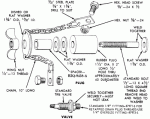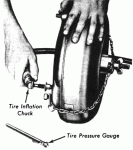yo, This is by Ford;
C4 Transmission Fluid Leakage Checks;
- Clean all dirt and grease from the transmission case.
- Inspect the speedometer cable connection at the extension housing of the transmission. If fluid is leaking here, disconnect the cable and replace the rubber seal.
- Inspect the oil pan gasket and attaching bolts for leaks. Tighten any bolts that appear loose to the proper torque (10–13 ft-lbs) Recheck for signs of leakage. If necessary, remove the pan attaching bolts and old pan gasket and install new gasket and reinstall the pan and its attaching bolts.
- Check filler tube connection at the transmission for signs of leakage. If tube is leaking, tighten the connection to stop the leak. If necessary, disconnect the filler tube, replace the O-ring, and reinstall the filler tube.
- Inspect all fluid lines between the transmission and the cooler core in the lower radiator tank. Replace any lines or fittings that, appear to be worn or damaged. Tighten all fittings to the proper torque.
- Inspect the engine coolant for signs of transmission fluid in the radiator. If there is transmission fluid in the engine coolant, the oil cooler core is probably leaking. The oil cooler core may be tested further by disconnecting all lines to it and applying 50–75 psi air pressure through the fittings. Remove the radiator cap to relieve any pressure buildup outside the cooler core. If air bubbles appear in the coolant or if the cooler core will not hold pressure, the oil cooler core is leaking and must be replaced.
- Inspect the openings in the case where the downshift control lever shaft and the manual lever shaft are located for leaks. If necessary, replace the defective seal.
- Inspect all plugs or cable connections in the transmission for signs of leakage. Tighten any loose plugs or connectors to the proper torque according to the specifications.
Remove the lower cover from the front of the bellhousing and inspect the converter drain plugs for signs of leakage. If there is a leak around the drain plugs, loosen the plug and coat the threads with a sealing compound and tighten the plug to the proper torque.
NOTE
Fluid leaks from around the converter area may be caused by the converter drain plug, oil pump seal, and/or gaskets, engine oil leakage past the rear main bearing seal, oil gallery plugs loose, valve cover gaskets, or the power steering system. To determine the exact cause of the leak before beginning repair procedures, an oil-soluble Aniline or fluorescent dye may be added to the leak detection process. When using the dye, a black light must be used to detect the dye within the oil.
If further converter checks are necessary, remove the transmission from the truck and the converter from the transmission. The converter cannot be disassembled for cleaning or repair. If the converter is leaking, it must be replaced with a new unit. To further check the converter for leaks, assemble and install the converter leak checking tool shown and fill the converter with 20 psi air pressure. Then, place the converter in a tank of water and watch for air bubbles. If no air bubbles are seen, the converter is not leaking.




